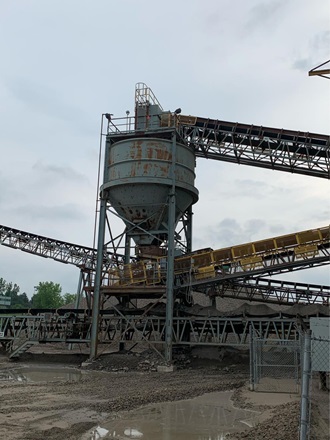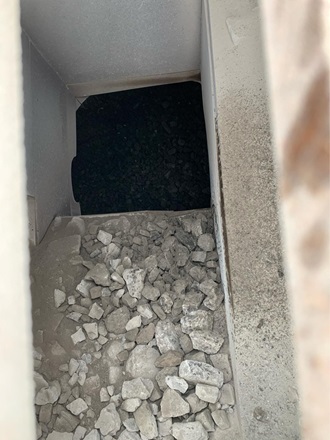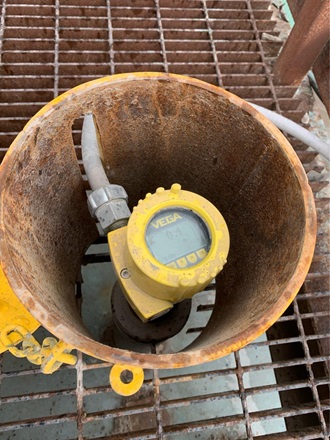Better level measurement technology prevents quarry process stops and starts |
The stone bin helps to ensure the correct amount of material moves from one end of the quarry to the other.
A global leader in building solutions operates quarries around the world, all of which provide the raw materials required to manufacture valuable construction and building supplies. Running all these quarries efficiently and economically is reliant on accurate and reliable level measurement instrumentation.
A large quarry in southern Ontario, Canada recently eliminated a bottleneck in their process when they replaced an ultrasonic level transmitter with a more reliable, more accurate radar level sensor in their stone bin. Both sensors make non-contact level measurements, but the differences between the two technologies enabled the radar sensor to outperform the previous sensor and overcome the difficulties of the application.
Dust and noise are hard on instrumentation
Every quarry operation is made up of multiple processes comprising of a series of crushers, conveyors, bins and more, making for a loud, dusty environment. Everything, including measurement instrumentation, gets covered with dust, and unless the sensors can operate in this environment, errors and failures are inevitable.
As material is conveyed into the stone bin through a small opening in the top, dust made it challenging for some level measurement technologies to make a reliably accurate reading.
The quarry in southern Ontario had been using an ultrasonic transmitter to measure the level in a stone bin. The conveyor feeding the bin speeds up when levels are low, slows down when levels are high, and stops completely when the bin is full.
False high level readings from the ultrasonic transmitter regularly brought the entire process to a grinding halt. Then, once operators fixed the error and got the process up and running again, large rocks would fall into an empty bin, causing increased wear and damage to the steel structure. Both these problems can be traced back to how ultrasonic transmitters operate, and how they handle dusty environments.
Ultrasonic transmitters make a measurement using a time-of-flight principle, sending sound waves toward the product surface and measuring the time it takes for the sound waves to return. Sound waves are mechanical waves, which means they require a medium to travel through – in this case, the air inside the stone bin.
Excessive dust in the air acts as a physical barrier to the sound waves, so it dampens both the transmission and the return signal. A dusty environment causes the sensor to output measurement errors, and if enough dust sticks and builds up on the sensor face, the sensor will output a level measurement at the face of the sensor – “full.” This is exactly what had been happening at the quarry in southern Ontario.
How a radar level sensor “sees” through the dust
The VEGAPULS 69 radar can reliably make level measurements through thick dust clouds because of the 80 GHz technology and intelligent software within the sensor.
This building solutions company has previously worked with VEGA for improved level measurement solutions at their other quarry locations around the world. Fortunately, VEGA has experience making measurements in high dust environments – and a proven solution with the 80 GHz VEGAPULS 69 radar level sensor.
Radar level measurements use the same time-of-flight principle, but instead of sound waves that require a medium through which to travel, they use radio microwaves, which can travel in a vacuum. This means the radar waves can travel through a dust-filled environment as if nothing is there.
The VEGAPULS 69 is specifically designed and built for bulk solids level measurements. Its 80 GHz transmission frequency delivers an enhanced focus for a more reliable measurement, and the intelligent electronics can read through the dust and buildup commonly found in quarry applications.
The quarry installed the VEGAPULS 69 radar level sensor on the stone bin, and it eliminated the previous issues. Operators began receiving accurate, reliable measurements immediately. The false high measurements and the regular process stops and starts became non-existent, improving efficiency and decreasing wear and tear on equipment.
Conclusion
High frequency radar sensors were designed and built to overcome the challenges associated with high dust environments. The VEGAPULS 69 thrives in dusty conditions where other level measurement technologies struggle to reliably output accurate level measurements.
Quarry operations in Ontario have been much smoother since installing the VEGAPULS 69. A radar sensor’s signal isn’t slowed down or weakened when thick dust clouds are present. Plus, the 80 GHz transmission frequency provides a narrow, more focused beam angle. Both factors ensure users continue to receive more reliable measurements they’ll be able to count on for years to come.
Related products
Export this article
Download as PDFShare this article
Comments ({{comments.length}})
{{getCommentAuthor(comment, "Anonymous")}} {{comment.timestamp | date : "dd.MM.yyyy HH:mm" }}
{{comment.comment}}








